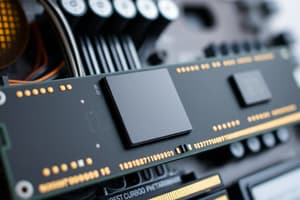Podcast
Questions and Answers
What is the primary function of the Control Unit in the CPU?
What is the primary function of the Control Unit in the CPU?
- Stores data temporarily
- Performs arithmetic and logical operations
- Executes program instructions
- Retrieves and decodes instructions (correct)
Which type of memory is non-volatile?
Which type of memory is non-volatile?
- Flash Drive
- ROM (correct)
- RAM
- HDD
What is the main function of the Motherboard?
What is the main function of the Motherboard?
- Stores data temporarily
- Executes program instructions
- Performs input/output operations
- Connects and supports various hardware components (correct)
What is the primary function of a Scanner?
What is the primary function of a Scanner?
What is the primary function of a Monitor?
What is the primary function of a Monitor?
What type of storage is RAM an example of?
What type of storage is RAM an example of?
What is the main difference between a Hard Disk Drive (HDD) and a Solid-State Drive (SSD)?
What is the main difference between a Hard Disk Drive (HDD) and a Solid-State Drive (SSD)?
What is the primary function of a Flash Drive?
What is the primary function of a Flash Drive?
What is the primary function of an External Hard Drive?
What is the primary function of an External Hard Drive?
Flashcards are hidden until you start studying
Study Notes
Hardware Components
- CPU (Central Processing Unit):
- Executes instructions and performs calculations
- Consists of:
- Control Unit: retrieves and decodes instructions
- Arithmetic Logic Unit (ALU): performs arithmetic and logical operations
- Memory:
- RAM (Random Access Memory):
- Temporary storage for data and program instructions
- Volatile (loses data when power is off)
- ROM (Read-Only Memory):
- Permanent storage for firmware and BIOS
- Non-volatile (retains data when power is off)
- RAM (Random Access Memory):
- Motherboard:
- Main circuit board of a computer
- Connects and supports various hardware components
Input/Output Devices
- Input Devices:
- Keyboard: enters text and commands
- Mouse: navigates and selects items
- Scanner: digitizes physical documents and images
- Webcam: captures video and images
- Output Devices:
- Monitor: displays text and images
- Printer: prints physical documents and images
- Speakers: produces audio
Storage Devices
- Primary Storage:
- RAM (Random Access Memory): temporary storage for data and program instructions
- Secondary Storage:
- Hard Disk Drive (HDD): stores large amounts of data magnetically
- Solid-State Drive (SSD): stores data electronically, faster than HDD
- Optical Discs: stores data optically (CD, DVD, Blu-ray)
- Flash Drives: portable, rewritable storage
- External Hard Drives: portable, external storage for large amounts of data
Hardware Components
- CPU (Central Processing Unit):
- Executes instructions and performs calculations
- Comprises Control Unit and Arithmetic Logic Unit (ALU)
- Control Unit retrieves and decodes instructions
- Arithmetic Logic Unit (ALU) performs arithmetic and logical operations
Memory
- RAM (Random Access Memory):
- Temporary storage for data and program instructions
- Volatile, losing data when power is off
- Data is accessed and written in a random order
- ROM (Read-Only Memory):
- Permanent storage for firmware and BIOS
- Non-volatile, retaining data when power is off
- Data is written during manufacturing and cannot be changed
Motherboard
- Main Circuit Board:
- Connects and supports various hardware components
- Acts as a communication pathway for components
Input/Output Devices
- Input Devices:
- Keyboard: enters text, commands, and data
- Mouse: navigates, selects, and interacts with graphical elements
- Scanner: digitizes physical documents and images into digital format
- Webcam: captures video and images
Output Devices
- Output Devices:
- Monitor: displays text, images, and videos
- Printer: prints physical documents and images
- Speakers: produces audio output
Storage Devices
- Primary Storage:
- RAM (Random Access Memory): temporary storage for data and program instructions
- Secondary Storage:
- Hard Disk Drive (HDD): stores large amounts of data magnetically
- Solid-State Drive (SSD): stores data electronically, faster than HDD
- Optical Discs: stores data optically (CD, DVD, Blu-ray)
- Flash Drives: portable, rewritable storage for small amounts of data
- External Hard Drives: portable, external storage for large amounts of data
Studying That Suits You
Use AI to generate personalized quizzes and flashcards to suit your learning preferences.




